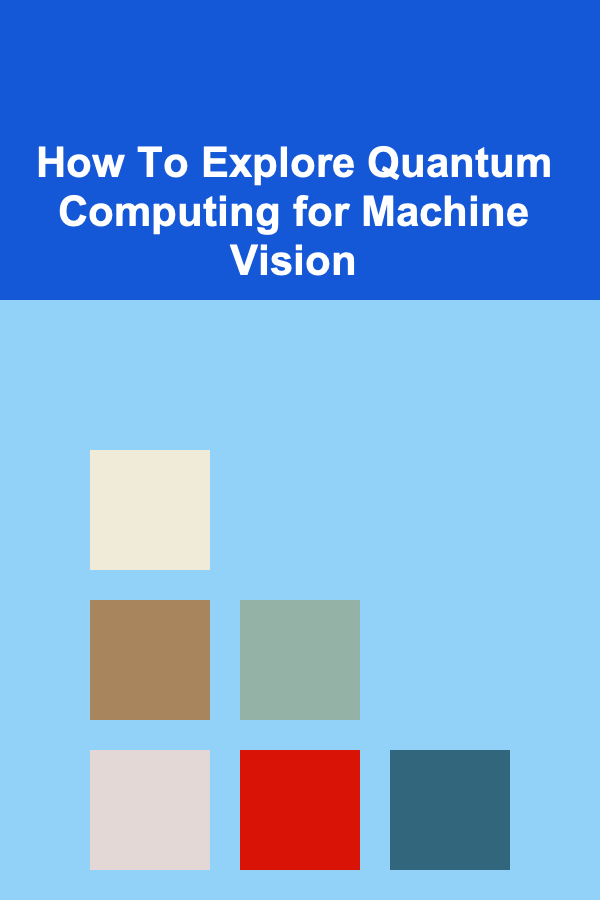
How To Explore Quantum Computing for Machine Vision
ebook include PDF & Audio bundle (Micro Guide)
$12.99$6.99
Limited Time Offer! Order within the next:

Quantum computing is one of the most groundbreaking advancements in technology. It leverages the principles of quantum mechanics to solve problems that are otherwise intractable for classical computers. In recent years, its potential applications have spread across a variety of fields, from cryptography and optimization to artificial intelligence (AI) and machine vision. Machine vision, in particular, has gained significant interest as it involves tasks such as image processing, pattern recognition, and object detection, which require enormous computational power.
Quantum computing presents an exciting avenue for improving and revolutionizing machine vision. In this article, we will delve into the intersection of quantum computing and machine vision, exploring how quantum principles can enhance traditional machine vision techniques, the challenges involved, and the future outlook.
Understanding Quantum Computing
Before we explore how quantum computing can be applied to machine vision, it's essential to understand the fundamentals of quantum computing.
Classical vs. Quantum Computing
In classical computing, data is processed using binary bits, which can be either a 0 or a 1. These bits are the fundamental unit of information in traditional computers. Quantum computing, however, uses quantum bits or qubits . Unlike classical bits, qubits can exist in multiple states simultaneously due to the quantum mechanical properties of superposition and entanglement.
- Superposition: A qubit can be in a state of 0, 1, or any superposition of both. This enables quantum computers to perform many calculations at once.
- Entanglement: This is a phenomenon where the state of one qubit is dependent on the state of another, no matter the distance between them. Entanglement allows for faster and more efficient data processing across multiple qubits.
Quantum Algorithms
Quantum algorithms, such as Shor's algorithm and Grover's algorithm, are designed to take advantage of quantum mechanics to solve specific problems more efficiently than classical algorithms. While Shor's algorithm can factorize large numbers in polynomial time, Grover's algorithm provides a quadratic speedup for searching unsorted databases.
Quantum algorithms have the potential to solve problems that are computationally expensive for classical systems, which opens doors to areas like optimization, simulation, and machine vision.
Machine Vision Overview
Machine vision refers to the ability of machines (or computers) to interpret and understand visual information from the world. It is closely related to computer vision, which involves extracting meaningful information from images and videos. Machine vision has applications across various industries, such as:
- Automated inspection in manufacturing
- Facial recognition in security systems
- Medical imaging for diagnostics
- Autonomous vehicles, which rely on vision systems to navigate
Machine vision systems typically involve several key components:
- Image Acquisition: This is the process of capturing images or video through cameras or other sensors.
- Image Processing: This involves transforming the raw images into useful data using techniques like filtering, edge detection, and segmentation.
- Pattern Recognition: This is where machine learning and AI algorithms come into play, identifying patterns, objects, or anomalies in the processed images.
- Decision Making: Finally, the processed information is used to make decisions or control systems.
Machine vision systems are traditionally computationally intensive, especially when dealing with large datasets or real-time processing. This is where quantum computing could potentially make a significant impact.
Quantum Computing for Machine Vision: The Potential
Speed and Efficiency
One of the primary advantages quantum computing offers is speed. Machine vision applications often require processing large datasets, such as high-resolution images or video streams, to extract meaningful information. This process can be computationally expensive, especially in real-time scenarios.
Quantum algorithms, by leveraging superposition and parallelism , can process a multitude of possibilities simultaneously. This could dramatically reduce the time it takes for a machine vision system to process large datasets. In particular, quantum computers could optimize key aspects of machine vision, such as image recognition , feature extraction , and object detection, all of which involve evaluating complex patterns in vast amounts of data.
Quantum Machine Learning
Machine learning, a subset of AI, plays a crucial role in modern machine vision systems. Quantum computing has the potential to accelerate machine learning algorithms through quantum machine learning (QML), which seeks to combine quantum computing and traditional machine learning techniques.
Quantum machine learning algorithms, such as Quantum Support Vector Machines (QSVM) and Quantum Neural Networks (QNN), could potentially offer exponential speedups in training and inference. These algorithms use quantum mechanics to represent and process data more efficiently than classical systems. As a result, they could enhance pattern recognition, anomaly detection, and predictive analysis in machine vision applications.
For instance, quantum neural networks can be used to train deep learning models more efficiently by processing large volumes of visual data faster. This could improve the accuracy and speed of machine vision systems, especially in complex scenarios like facial recognition, where the system must analyze and compare high-dimensional data.
Optimization Problems in Machine Vision
In machine vision, optimization problems are common, particularly when searching for patterns or identifying objects in noisy or cluttered images. These problems often involve finding the best possible solution among many possibilities, which is computationally expensive for classical computers.
Quantum computing can help solve optimization problems more efficiently using algorithms like Quantum Approximate Optimization Algorithm (QAOA). QAOA is particularly suited for problems in machine vision, such as image segmentation and object recognition, where the goal is to find the optimal configuration of features or pixels that best represents the image.
Image Processing and Quantum Fourier Transforms
One area where quantum computing could shine in machine vision is image processing . Classical image processing involves techniques like Fourier transforms, which decompose an image into its frequency components. These transformations are used for filtering, compression, and edge detection.
Quantum computers could speed up these image processing techniques using the Quantum Fourier Transform (QFT), which is exponentially faster than the classical Fourier Transform. This could enable faster image processing for real-time machine vision systems.
Quantum Simulations
Quantum computers are particularly adept at simulating physical systems, which could have implications for machine vision systems that rely on physical models. For example, quantum simulations could be used to model the interaction of light with objects in a scene, improving the accuracy of 3D reconstruction in machine vision applications.
Additionally, quantum simulations could help improve material inspection in manufacturing, where machine vision systems need to analyze surface defects at microscopic scales. Quantum simulations could provide more accurate models of how light interacts with different materials, improving defect detection accuracy.
Challenges in Integrating Quantum Computing with Machine Vision
While the potential of quantum computing for machine vision is immense, there are several challenges that need to be addressed before it can be fully realized.
Quantum Hardware Limitations
One of the most significant challenges in exploring quantum computing for machine vision is the current state of quantum hardware. Quantum computers are still in the early stages of development, and they are highly susceptible to errors and noise. For practical applications like machine vision, quantum computers need to be more stable and scalable.
Currently, the qubits in most quantum computers are prone to decoherence, which occurs when the quantum state of a qubit is disturbed by its environment. This can lead to errors in calculations and make it difficult to execute complex quantum algorithms reliably.
Lack of Quantum Software for Machine Vision
Another challenge is the lack of mature quantum software libraries tailored for machine vision. While there are several quantum computing frameworks, such as Qiskit and Cirq, these are generally focused on quantum chemistry, optimization, or other domains rather than machine vision. As quantum computing evolves, the development of specialized quantum software for machine vision will be crucial to unlocking its full potential.
Integration with Classical Systems
Most machine vision systems today rely on classical computing hardware, and integrating quantum computing with these systems presents a challenge. Quantum computers are not yet ready to fully replace classical systems but may serve as a co-processor to enhance specific tasks.
The integration of quantum computing with classical systems requires the development of hybrid computing models, where quantum and classical systems work together. This hybrid model will need to be optimized for performance, taking into account the strengths and weaknesses of both quantum and classical computers.
Scalability and Cost
Quantum computers, particularly those based on superconducting qubits or trapped ions, are currently expensive to build and operate. As quantum computers scale, the costs of hardware and maintenance are expected to rise. This could limit the accessibility of quantum computing for machine vision applications, especially for small businesses or individual developers.
The Future of Quantum Computing in Machine Vision
Despite the challenges, the future of quantum computing in machine vision is promising. As quantum hardware and algorithms continue to improve, we can expect to see significant advancements in the capabilities of machine vision systems.
The development of quantum-inspired algorithms could also pave the way for practical applications even before quantum hardware reaches full maturity. These algorithms aim to mimic quantum principles using classical systems, providing some of the benefits of quantum computing without the need for quantum hardware.
In the long term, as quantum computing becomes more accessible and practical, it could revolutionize machine vision by making systems faster, more accurate, and capable of solving problems that are currently intractable for classical systems.
Conclusion
Quantum computing holds immense potential to revolutionize machine vision. By leveraging quantum principles such as superposition, entanglement, and quantum algorithms, we can enhance the performance of machine vision systems, enabling faster processing, more accurate pattern recognition, and better optimization. However, significant challenges remain, particularly with quantum hardware, software, and integration with classical systems.
Despite these obstacles, the future of quantum computing in machine vision is bright. With continued advancements in both hardware and software, we can expect quantum computing to play a pivotal role in the next generation of machine vision technologies, enabling breakthroughs across a wide range of industries.

Becoming a Successful Chief Financial Officer: Essential Skills for Financial Leaders
Read More
How to Create a Functional Family Room with Thoughtful Arrangements
Read More
How to Recognize and Thank Donors for Their Contributions
Read More
How to Soundproof a Tiny Home or Mobile Home
Read More
How To Write a Compelling Call to Action
Read More
How to Plan Your Day with a Digital Daily Planner App
Read MoreOther Products

Becoming a Successful Chief Financial Officer: Essential Skills for Financial Leaders
Read More
How to Create a Functional Family Room with Thoughtful Arrangements
Read More
How to Recognize and Thank Donors for Their Contributions
Read More
How to Soundproof a Tiny Home or Mobile Home
Read More
How To Write a Compelling Call to Action
Read More